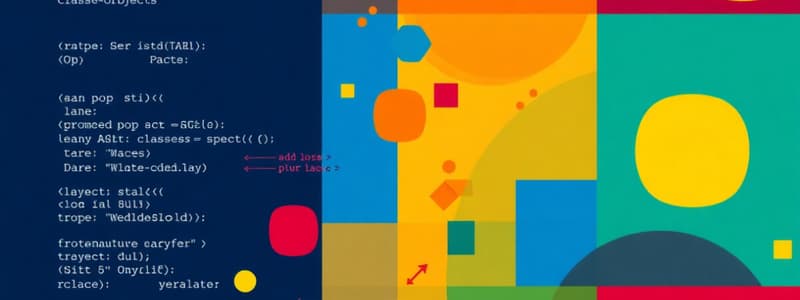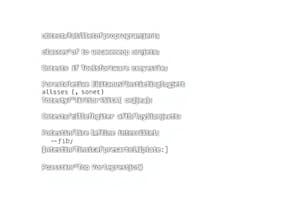Podcast
Questions and Answers
What is the primary function of a class in OOP?
What is the primary function of a class in OOP?
- To represent a blueprint for creating objects (correct)
- To contain only methods without any variables
- To serve as a data structure only
- To store data without any associated behaviors
Which of the following describes instance variables?
Which of the following describes instance variables?
- They hold the state of an object (correct)
- They are global variables accessible by all objects
- They are temporary storage for methods only
- They are methods that operate on the class
What role do constructors play in OOP?
What role do constructors play in OOP?
- They are used solely for data storage
- They initialize an object’s state upon creation (correct)
- They create classes without objects
- They define how methods behave
How do you retrieve the value of an object's attribute in OOP?
How do you retrieve the value of an object's attribute in OOP?
Which statement accurately distinguishes between primitive and reference types?
Which statement accurately distinguishes between primitive and reference types?
Which of the following correctly describes methods in a class?
Which of the following correctly describes methods in a class?
What is the purpose of set methods in OOP?
What is the purpose of set methods in OOP?
What is required to perform a task in a program?
What is required to perform a task in a program?
Which component of a class defines its attributes?
Which component of a class defines its attributes?
How does a class relate to a car's engineering drawings?
How does a class relate to a car's engineering drawings?
What is an object in the context of a class?
What is an object in the context of a class?
Why is reuse of classes beneficial in programming?
Why is reuse of classes beneficial in programming?
What is the main purpose of using objects in software development?
What is the main purpose of using objects in software development?
What does the term 'instantiation' refer to in object technology?
What does the term 'instantiation' refer to in object technology?
Which of the following is NOT a method associated with a bank account object?
Which of the following is NOT a method associated with a bank account object?
Which property is NOT typically associated with an automobile object?
Which property is NOT typically associated with an automobile object?
What is a characteristic of methods within a class?
What is a characteristic of methods within a class?
What analogy is drawn between interchangeable parts in the Industrial Revolution and class reuse in programming?
What analogy is drawn between interchangeable parts in the Industrial Revolution and class reuse in programming?
What does pressing the brake pedal in a car represent in terms of object-oriented design?
What does pressing the brake pedal in a car represent in terms of object-oriented design?
What essential component allows a car to accelerate?
What essential component allows a car to accelerate?
In object-oriented programming, which component is analogous to the engineering drawings of a car?
In object-oriented programming, which component is analogous to the engineering drawings of a car?
Which of the following best describes an instance in the context of an object?
Which of the following best describes an instance in the context of an object?
What is the main type of parameter used in the context of a vehicle's brake system?
What is the main type of parameter used in the context of a vehicle's brake system?
Which of the following components would you expect to find in a grade book object?
Which of the following components would you expect to find in a grade book object?
What is the default value of reference-type instance variables in Java?
What is the default value of reference-type instance variables in Java?
Which keyword is used to create an object in Java?
Which keyword is used to create an object in Java?
What must a constructor in Java have in relation to its class?
What must a constructor in Java have in relation to its class?
What happens if a class in Java explicitly defines a constructor?
What happens if a class in Java explicitly defines a constructor?
Why can't constructors in Java specify a return type?
Why can't constructors in Java specify a return type?
What does a constructor's parameter list indicate?
What does a constructor's parameter list indicate?
Which statement about the default constructor provided by the compiler is true?
Which statement about the default constructor provided by the compiler is true?
What will happen when creating an object from a class without any defined constructors?
What will happen when creating an object from a class without any defined constructors?
What does pressing the gas pedal in a car represent in the context of object technology?
What does pressing the gas pedal in a car represent in the context of object technology?
Which of the following correctly describes attributes in the context of object-oriented programming?
Which of the following correctly describes attributes in the context of object-oriented programming?
What is the purpose of the keyword 'public' in a class declaration?
What is the purpose of the keyword 'public' in a class declaration?
In object-oriented programming, how is an object's state represented?
In object-oriented programming, how is an object's state represented?
What does a method call do in the context of an object?
What does a method call do in the context of an object?
What is true about instance variables in a class?
What is true about instance variables in a class?
Which statement correctly describes a class in object-oriented programming?
Which statement correctly describes a class in object-oriented programming?
What does an object's method generally do?
What does an object's method generally do?
What describes an instance variable within a class?
What describes an instance variable within a class?
Which access modifier is typically used for instance variables?
Which access modifier is typically used for instance variables?
What is the purpose of set and get methods associated with instance variables?
What is the purpose of set and get methods associated with instance variables?
How does the instance of a class handle memory for its instance variables?
How does the instance of a class handle memory for its instance variables?
Which statement is true about instance variables and their accessibility?
Which statement is true about instance variables and their accessibility?
What happens to instance variables after a method that modifies them completes execution?
What happens to instance variables after a method that modifies them completes execution?
What is meant by data hiding in the context of instance variables?
What is meant by data hiding in the context of instance variables?
Which statement is correct regarding the execution timing of methods in a class?
Which statement is correct regarding the execution timing of methods in a class?
Flashcards
Class
Class
A blueprint or template that defines the structure and behavior of objects. It specifies the data (attributes) an object of that class will have and the actions (methods) it can perform.
Object
Object
An instance of a class; a concrete realization of a class. It possesses the attributes and methods defined by the class.
Attributes (Instance Variables)
Attributes (Instance Variables)
Data that represents the state of an object. They are variables defined within a class that store information about the object.
Methods
Methods
Signup and view all the flashcards
Parameters
Parameters
Signup and view all the flashcards
Set Methods
Set Methods
Signup and view all the flashcards
Get Methods
Get Methods
Signup and view all the flashcards
Constructor
Constructor
Signup and view all the flashcards
Message
Message
Signup and view all the flashcards
Method Call
Method Call
Signup and view all the flashcards
Instance Variables
Instance Variables
Signup and view all the flashcards
Instantiating an Object
Instantiating an Object
Signup and view all the flashcards
Public
Public
Signup and view all the flashcards
Instantiation
Instantiation
Signup and view all the flashcards
Reuse
Reuse
Signup and view all the flashcards
Code Reuse
Code Reuse
Signup and view all the flashcards
Instance
Instance
Signup and view all the flashcards
Property/Field
Property/Field
Signup and view all the flashcards
Function/Method
Function/Method
Signup and view all the flashcards
Objects in software development
Objects in software development
Signup and view all the flashcards
Object-oriented programming
Object-oriented programming
Signup and view all the flashcards
Default Constructor
Default Constructor
Signup and view all the flashcards
Public Constructor
Public Constructor
Signup and view all the flashcards
null
null
Signup and view all the flashcards
Invoking Methods
Invoking Methods
Signup and view all the flashcards
Keyword new
Keyword new
Signup and view all the flashcards
Constructor Naming
Constructor Naming
Signup and view all the flashcards
Private Access Modifier
Private Access Modifier
Signup and view all the flashcards
Object Instantiation
Object Instantiation
Signup and view all the flashcards
Data Hiding (Encapsulation)
Data Hiding (Encapsulation)
Signup and view all the flashcards
Setters and Getters
Setters and Getters
Signup and view all the flashcards
Instance Variables - Each Object Has Its Own
Instance Variables - Each Object Has Its Own
Signup and view all the flashcards
Study Notes
Chapter 3 OOP Main Concepts
- Chapter 3 focuses on Object-Oriented Programming (OOP) core concepts.
- The chapter covers objects versus classes, identifying objects, distinguishing between states and behaviors.
In Chapter 2, we have learned
- Using different input statements
- Basic concepts of memory (variables)
- Arithmetic operators
- Compound assignment operator
- Increment and decrement operators
- Java's primitive data types
- Logical operators
- Selection statements (if, if...else, switch)
- Repetition statements (for, while, do...while, break, continue)
In Chapter 3, you will learn
- Declaring classes and creating objects
- Defining class behaviors as methods
- Implementing class attributes as instance variables/properties
- Calling object methods
- Understanding instance variables and local variables within methods
- Using constructors to initialize object data
- Employing set and get methods for accessing object data.
- The differences between primitive and reference types
Chapter 3 Content
- Introduction to OOP
- Declaring classes with methods.
- Instantiating objects from classes
- Declaring methods that take parameters
- Instance variables and get/set methods
- Initializing objects with constructors
Introduction
- Covered topics in this chapter include:
- Objects
- Classes
- Instance variables
- Methods
- Parameters
- Primitive data types (like double)
Graphical Example of OOP
- Depicts a "CLASS" as a box with "State/Attribute" and "Behaviors/Methods" compartments.
- Arrows from CLASS to individual "OBJECTS" (Object 1, Object 2, and Object 3).
Introduction - Examples
- Object: Car
- Class: Design of a Prius
- Class: Account.java
- Class: GradeBook.java
- Object Instance: My Prius
- Field Example: Engine, Color
- Method Example: Drive, Park, Brake
- Parameter: How hard you press the brake
- Object Related Value: Amount to deposit
Introduction to Object Technology
- Objects are reusable software components
- Represent items like date objects
- Represent behaviors such as calculating or communicating
- Modern software development benefits from modular object-oriented designs.
Introduction to Object Technology (Cont.)
- Explains how Objects work in everyday life using a car analogy
- Introduces OOP concepts analogous to mechanical systems
- Describes how parts of a car (like accelerator) hide complex inner mechanisms from the user.
Introduction to Object Technology (Cont.)
- Clearly outlines the role of objects in supporting simpler interaction with complex systems.
- Re-emphasizes object construction as a required precursor to usage.
Methods and Classes
- Methods are crucial for performing tasks within a program.
- Methods encapsulate instructions and hide implementation details from the user.
- Java organizes method collections into classes, similar to engineering diagrams representing a car.
Instantiation
- Building an object from its class definition
- An object is a class instance (similar to creating a car from its diagram).
- Need to create an object before running the program
Reuse
- Reusable software components (classes) are essential for software development efficiency
- Reusing existing components saves time
- Efficient reuse, with comprehensive testing, leads to robust systems
Software Engineering Observation 1.1
- Encourage the reuse of existing program components (classes) whenever possible.
- Using existing components avoids reinventing solutions and leads to more reliable software.
Introduction to Object Technology (Cont.) - Messages and Methods Calls
- Messages (e.g., pressing accelerator) are sent to objects to trigger actions.
- Method calls implement these messages to instruct objects accordingly.
Introduction to Object Technology (Cont.) - Attributes and Instance Variables
- Objects have attributes (properties) like color, speed.
- Attributes are also known as instance variables and are part of the object's design.
- Each object has its own attributes, distinct from attributes of other objects of the same class,
Introduction to Object Technology (Cont.)
- Objects have associated attributes (instance variables) that define their characteristics
- Attributes are crucial as they define the object's qualities, stored within the class's structure.
- Information is kept in each object itself.
Declaring a Class with a Method and Instantiating an Object of a Class
- New class definition: requires keyword 'public' in declaration, and must be stored in a file with the same name that ends with '.java'.
- Creating an object requires the 'new' keyword
Declaring a Class with a Method and Instantiating an Object of a Class (Cont.)
- Method naming conventions: utilize lowercase first letter and subsequent words with capital letters
- Empty parentheses indicate methods that don't need additional information to function.
- Methods and parameters are grouped inside curly brackets{}
Declaring a Class with a Method and Instantiating an Object of a Class (Cont.)
- A class without a 'main' method is not an application (it can't run directly); instead a 'main' method needs to be in a separate driver class to run the program.
Declaring a Class with a Method and Instantiating an Object of a Class (Cont.) -Instantiation
- Creating an object of a class before running the program is necessary.
- Objects are considered instances of their associated classes.
Declaring a Class with a Method and Instantiating an Object of a Class (Reuse)
- Reusability of classes to make many objects
- Reusable classes avoid excessive work and create more reliable programs
Declaring a Class with a Method and Instantiating an Object of a Class (Compiling an Application)
- Compile Java files using a 'javac' command
Declaring a Class with a Method and Instantiating an Object of a Class (UML)
- Uses a standardized diagram to represent classes and their attributes
- Classes are represented as boxes, divided into compartments for their name, attributes, and operations
Declaring a Method with a Parameter
- Methods can accept parameters—additional information for tasks
- Parameters provide needed data during object method calls; this is similar to how pressing a car's gas pedal applies more or less force to change acceleration
Declaring a Method with a Parameter (Cont.)
- Methods can need multiple, comma-separated parameters
- Method parameters need a type definition and identifier
- A method's call uses the argument values corresponding to the method parameters
Declaring a Method with a Parameter (Scanner)
- nextLine() : reads characters until a newline is entered
- next(): reads up to and excluding a white-space character
Declaring a Method with a Parameter (Cont.)—Arguments and Parameters
- Matching argument counts and data types with parameters is essential
- Errors result from inconsistent data type and count matches
Instance Variables, set Methods and get Methods
- Local variables only exist within a method. Local variables disappear when the method ends.
- An object's attributes (instance variables) are persistent across the program's run.
Instance Variables, set Methods and get Methods (Cont.)
- Methods are part of a class to manipulate object attributes
- Attributes act like fields stored inside the class; they are declared outside methods
- Methods often manipulate private fields through public methods (set, get methods)
Instance Variables, set Methods and get Methods (Cont.)—private
- Access modifiers like "private" hide information to prevent unintended access from outside the class.
Instance Variables, set Methods and get Methods (Cont.)—set/get methods
- 'set' methods change data; 'get' methods retrieve data.
Instance Variables, set Methods and get Methods (Cont.)
- Methods specifying a non-void return type will return a specific value.
- Methods can call other methods of the same class using only the method name.
Instance Variables, set Methods and get Methods (Cont.)—Initial Values
- Instance variables have default values. (e.g., String values are null)
- Developers must provide initial values if default values aren't suitable
Initializing Objects with Constructors
- Instance variables initialized when an object is created; often to default values
- Constructors allow for customizing object initialization
- Constructors must have the same name as the class
Initializing Objects with Constructors (Cont.)
- Constructors can contain parameters to specify initialization values
- Constructors, unlike methods, are not called directly; the 'new' keyword implicitly calls the corresponding constructor when creating an object
Primitive Types vs. Reference Types
- Primitive types (e.g., int, float) store single values directly.
- Reference types (e.g., objects) store memory locations, which can point to objects in memory that hold data that is not primitive.
Thank You
- Reading list provided (book title, author with ISBN information)
Studying That Suits You
Use AI to generate personalized quizzes and flashcards to suit your learning preferences.




